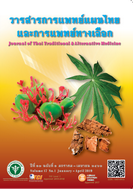Nutritional Values and Prebiotic Properties of Ma-Now-Mai-Roo-Hoo Fruits
Main Article Content
Abstract
This study aimed to investigate the primary chemical compositions, nutritional values, and prebiotic properties of both unripe and ripe ma-now-mai-roo-hoo fruits (Carissa carandas L.). The parts of the fruit used were (1) pulp + peel of unripe: PP (W/R), (2) seed coat + seed of unripe: PS (W/R), (3) pulp + peel of ripe: PP (Dm) and (4) seed coat + seed of ripe: PS (Dm). The nutritional value of Ma-now-mai-roo-hoo fruits was studied by proximate analysis. Lactobacillus acidophilus TISTR 1338 was used to study prebiotic activities. The results show that protein and fiber in PS (W/R) exhibited the highest values; 28.48 ± 0.32% and 14.14 ± 0.46%, respectively. Fat and carbohydrates showed the highest values in PP (Dm); 12.30 ± 0.29% and 51.14 ± 0.78%, respectively. In the prebiotic experiment, it was observed that the medium containing PP (W/R) and PP (Dm) in the concentration of 4.5 exhibited the highest turbidity of L. acidophilus TISTR 1338 (0.071 and 0.094, respectively) after 48 hours of the incubation period, indicating an increase in the growth rate of the bacteria. This study shows that both the unripe and ripe fruits of Ma-now-mai-roo-hoo have the potential to be an alternative source of food and can be developed as a natural alternative to health care products.
Article Details
References
2. Khow-ean U. Probiotics. Songklanagarind Medical Journal. 2006.;24(4):315-23. (in Thai)
3. Chaiyasut C, Sirilum S. Probiotics: Beneficial Microorganisms for Health. Journal of Bureau of Alternative Medicine. 2010;3(3):4-16. (in Thai)
4. Song SK, Beck BR, Kim D, Park J, Kim J, Kim HD, Ringø E. Prebiotics as immunostimulants in aquaculture: A review. Fish & Shellfish Immunology. 2014;40(1):40-8.
5. Wetwitayaklung P, Charoenteeraboon J, Limmatvapirat C, Phaechamud T. Antioxidant Activities of Some Thai and Exotic Fruits Cultivated in Thailand. Research Journal of Pharmaceutical, Biological and Chemical Sciences. 2012;3(1):12-21.
6. Maheshwari R, Sharma A, Verma D. Phyto-therapeutic Significance of Karaunda. Bulletin of Environment Pharmacology and Life Sciences. 2012;1(12):34-6.
7. Sharma A, Tiwari R.K, Kaushik A, Tyagi L.K, Shankar K, Virmani T, Yadav S, Parvez N. Standardisation of Carissa carandas Linn: A drug used in indian system of medicine as per W.H.O. guidelines. Continental Journals Pharmaceutical Sciences. 2007;1;9-14.
8. Patel P.R, Rao T.V.R. Physiological changes in Karanda (Carissa carandus L.) fruit during growth and ripening. Nutrition and Food Science. 2013;43(2):128-36.
9. Garg V.K, Paliwal S.K, Sharma S. Analgesic and antipyretic activities of aqueous extract of leaves of Carissa carandas Linn. Pharmacologyonline. 2011;1(1):1109-19.
10. Itankar PR, Lokhande, SJ, Verma PR, Arora SK, Sahu RA, Patil AT. Antidiabetic potential of unripe Carissa carandas Linn. fruit extract. Journal Ethnopharmacology. 2011;135(2):430-3.
11. Horwitz W. Official Methods of Analysis of AOAC International. USA: Gaithersburg; 2000.
12. Gustaw W, Wiater M.K, Koziol J. The influence of selected prebiotics on the growth of lactic acid bacteria for bio-yoghurt production. Acta scientiarum Polonorum, Technologia alimentaria. 2011;10(4):455-66.


